Westnewton WwTW (2020)

Extract from the 3D model showing view of Nereda® plant - Courtesy of United Utilities
Westnewton is a small village about three and a half miles from the Solway coast at Allonby and eight miles west of the market town of Wigton. The wastewater treatment works is situated on a hillside above the village and treats wastewater for 275 population equivalent (PE) from the village and the local area. The sewage network feeds into a terminal pumping station on the main road just below the treatment works and is then pumped up to the works for treatment. The final effluent then flows via the works outfall into Westnewton Beck, which runs to the north of the site.
Project drivers
Westnewton WwTW has been named in the Environment Agency’s (EA) National Environment Programme (NEP) Phase 5, with a Water Framework Directive (WFD). The aim of this project is to improve the quality of the receiving watercourse (Westnewton Beck) to ‘good’ from its current status of ‘moderate’ thereby contributing 7.48km to the Rivers Improved performance commitment.
Traditional solutions for phosphorus removal at wastewater treatment works require chemical coagulant dosing and often pH correction. At United Utilities, 34 new phosphorus permits were introduced in AMP6 and there will be another 51 new permits in AMP7. Many of these permits are coming into force at small works where dosing can be difficult (due to access, intermittent flows, low flows, poor mixing and the need for a potable water supply for chemical safety showers) so the company needed to find more effective solutions for these types of sites to become less chemically dependent.
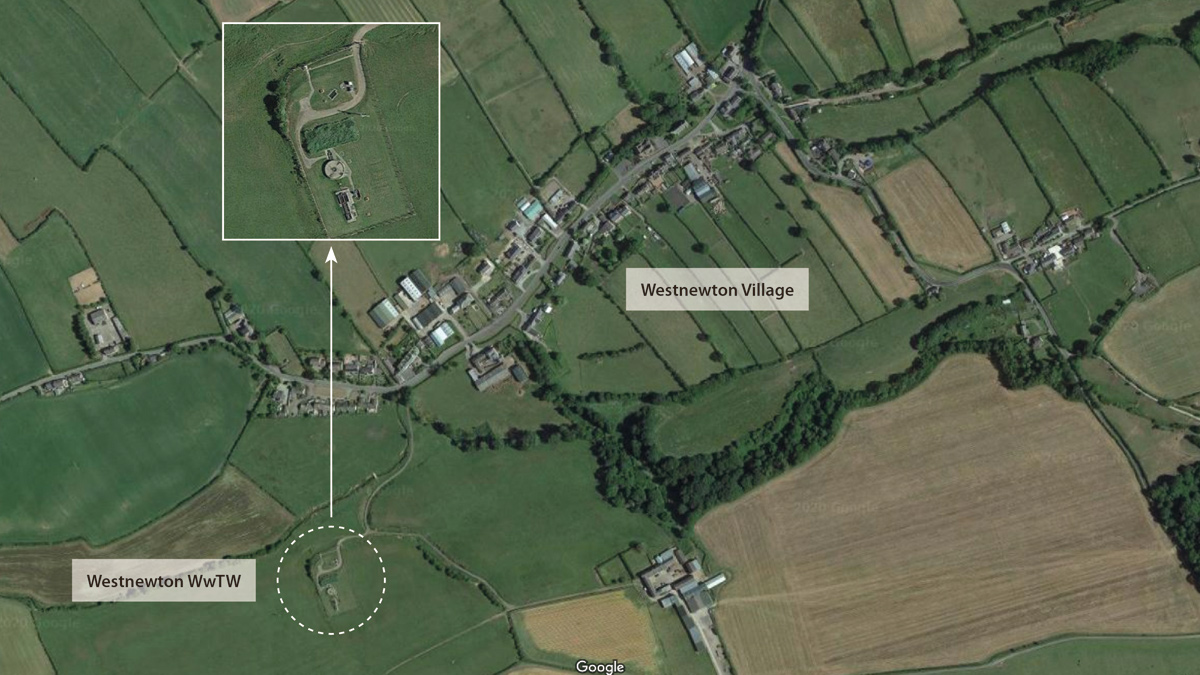
Google map showing Westnewton village and the location of the wastewater treatment works – Courtesy of United Utilities
Nereda® technology
Nereda® is a treatment technology that treats wastewater using the novel and unique features of aerobic granular biomass which promote the biological removal of phosphorus. United Utilities has a long history of trialling and implementing the Nereda® technology starting in 2013 which led to the company awarding four contracts for Nereda® solutions at population equivalent (PE) values ranging from 23,000 to 400,000. The last and largest of the four contracts at Blackburn will commence commissioning in autumn 2020 and when built it will be the largest new build PE Nereda of its kind in Europe.
Previously, the Nereda® supplier (Royal HaskoningDHV) had only ever delivered large scale Nereda® solutions. In contrast to the large plants mentioned above, during the work on the Nereda® trials at United Utilities, the opportunity to develop a package solution for small works was identified. Royal HaskoningDHV has since developed small (Package) and medium scale (Mini) solutions for 200-2,000 PE and 2,000-5,000 PE respectively, with support from UU and C2V+ (United Utilities’ construction design partner for their second largest Nereda plant at Morecambe and now the first ever package site at Westnewton WwTW).
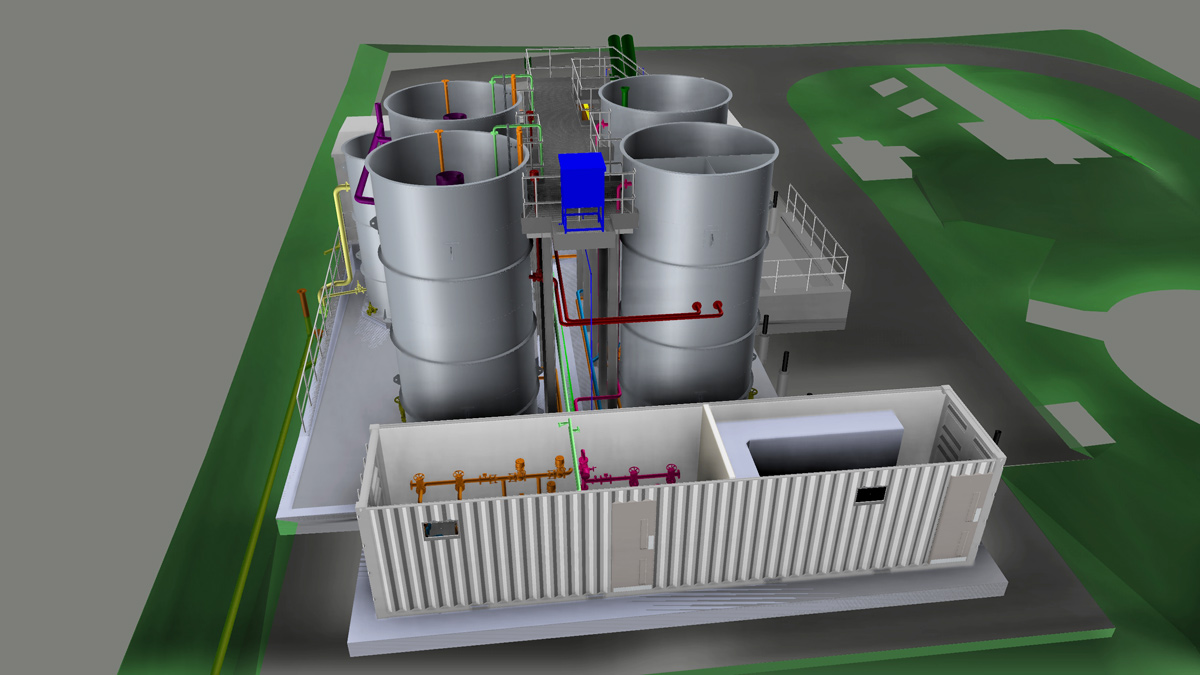
Extract from 3D model showing control building (with roof removed) and Nereda® reactors – Courtesy of United Utilities
Package and Mini Nereda® concept
The Package and Mini Nereda® concepts are a ‘design one, build many’ approach and United Utilities alongside C2V+ have been working with Royal HaskoningDHV to agree the standard layout designs. The solutions will feature a similar Nereda® controller to the larger systems, but batch control will be based on pH alone to reduce the amount of complex instrumentation required which can prove difficult to maintain at small unmanned sites.
Further benefits of the small scale Nereda® solutions to United Utilities include:
- Lower whole life cost.
- Reduced company chemical use and tanker movements due to the move to biological phosphorus removal.
- Smaller footprint compared to conventional solutions.
- Reduced reliance on ageing assets for phosphorus removal when adding chemical dosing to existing works.
- Circular economy (as it opens the door for recovery of products like phosphorus and alginate).
- Alignment with our systems thinking strategy.
Westnewton WwTW
Westnewton is a 275 PE site which discharges into Westnewton Beck. In order to improve the quality of water in the beck, United Utilities are looking to improve the final effluent from the site to achieve a permit of 0.85 mg/l of phosphorus on an annual average basis. In reviewing the ability of the plant to meet this requirement, of particular concern was that the site had a number of ageing assets at the end of their life cycle which needed replacing and could lead to significant risk associated with adding a chemical dosing solution. Following contract award to C2V+, the detailed design commenced.
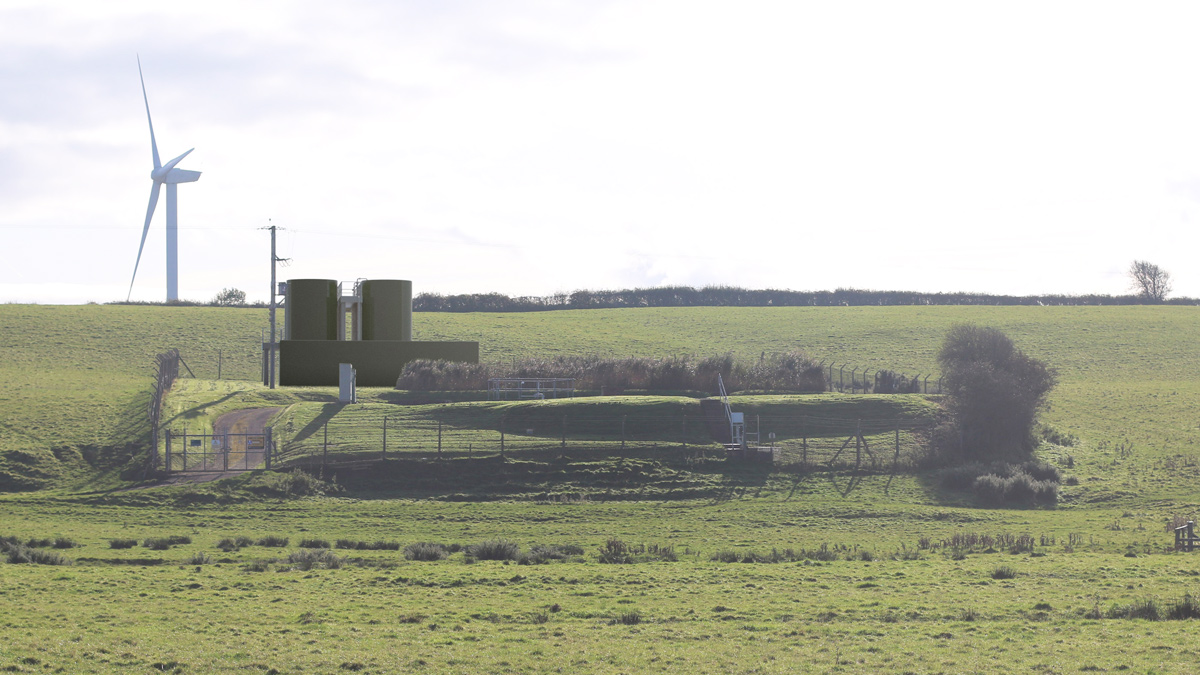
Extract from planning montage – Courtesy of United Utilities
Design development
C2V+ worked closely with United Utilities, Royal HaskoningDHV and Suprafilt to develop the detailed design for Westnewton WwTW. Initially collaborative meetings were held fortnightly to decide on key decisions such as the number of Nerada tanks, the type of inlet works required, the standby generator strategy and how to work within the EA permit.
Once a conceptual HAZOP had been held to identify significant issues around control and operation, a 3-month period of detailed design development was undertaken which focussed on finalising the process design and P&IDs, the layout of the control housing container, the reactors and the inlet works. Use of BIM 3D models allowed the whole team to satisfy themselves that assets could be constructed, operated and maintained safely.
Building information modelling (BIM) is a systems approach to the design construction, commissioning, ownership, management, operation, maintenance use, demolition and reuse of built assets. It includes people, processes, standards and methods. The main benefits of utilising BIM for Westnewton detailed design were:
- Reducing rework through federation (including clash detection) of fully coordinated and intelligent 3D models.
- Improving productivity of drawing production.
- Capturing reality including integration with GIS data, aerial imagery, 360o photography, laser scanning etc.
- Maintaining full history of construction process.
- Improving collaboration between parties.
- Providing simulations and visualisations.
- Reducing fragmentation through model federation that gives full picture of the project.
The developed design was subjected to a detailed HAZOP and a separate access, lifting and maintenance (ALM) review in line with UU’s procedures.
Planning
Care was taken to ensure the visual impact of the works on the village would be acceptable to the local residents. A planning application was submitted and montages were produced. A public exhibition was held in Westnewton town hall in December 2019, prior to any works commencing on site.
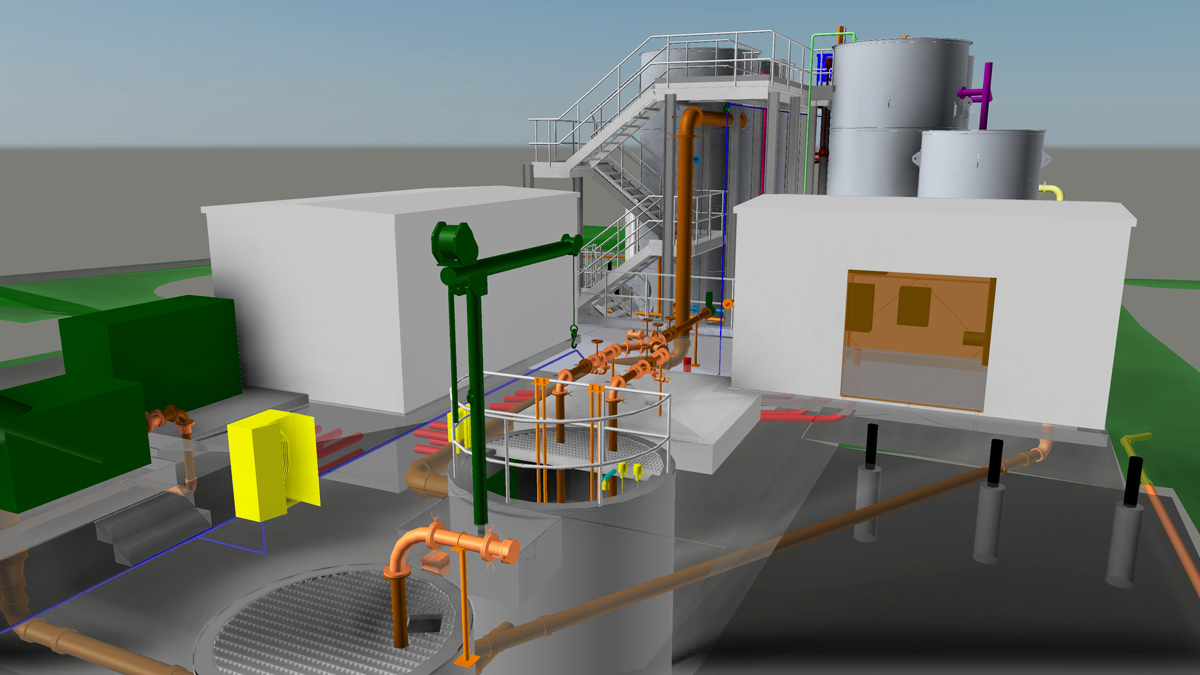
Extract from the 3D model showing view of Nereda® feed pumping station – Courtesy of United Utilities
Extract from the 3D model showing view of Nereda® feed pumping station – Courtesy of United Utilities
Westnewton WwTW: Supply chain – key participants
- Client: United Utilities
- Main construction contractor: C2V+
- Nereda® process: Royal HaskoningDHV
- Nereda® internals & general MEICA installation: Suprafilt
- General MEICA installation: Austin Lenika
- Inlet screens: Huber Technology
- Washwater booster system: Grundfos
- Sludge progressive cavity pumps (Westnewton): SEEPEX UK Ltd
- Systems integration: Tata Consultancy Services
- MCCs: Lloyd Morris Electrical Ltd
Progress to date (September 2020)
Civil construction took place over the period April to September 2020 to take advantage of summer weather conditions. The existing access track featured sharp bends unsuitable for the majority of deliveries, so a temporary Terrafirma Roadway was installed to allow suitable access for the duration of construction.
The project is principally based around off-site manufacture, meaning the majority of the civil works comprised of simple ground bearing slabs. A number of small excavations were required for a grit chamber, Nereda® feed pumping station and MCC cable trench. The inlet screens are due for delivery at the beginning of October followed by the Nereda® plant in November. Construction completion is scheduled for early January 2021.
The proposed new infrastructure requires a power upgrade to the existing site and this is due to be installed before commissioning commences.
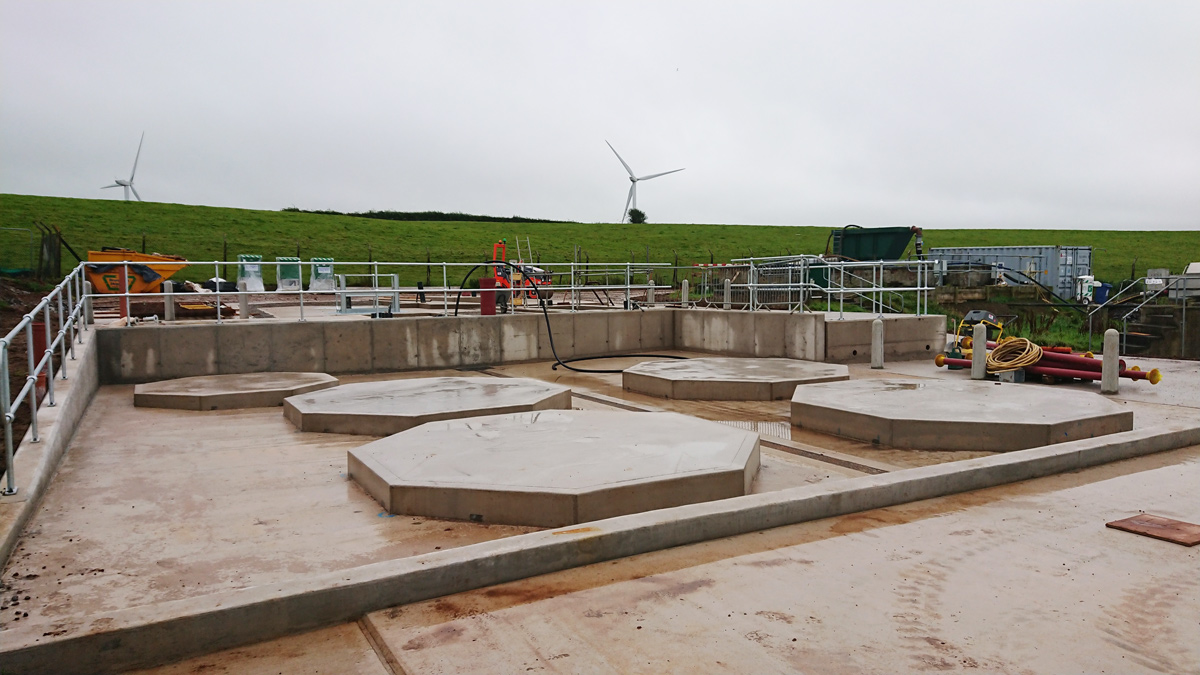
Nereda® base slab with plinths – Courtesy of United Utilities
Conclusion
At the time of writing (September 2020), the concrete structures have been constructed and are ready to receive the process units once delivered to site in the next few months. Commissioning and completion is anticipated to be early 2021.
The solution at Westnewton will be a global first, proving the success of the long-established relationship between the three parties. As a first adopter of this technology, United Utilities continues to secure their place as one of the leading innovators in the UK water industry.






